Your calf is one of the most under-trained muscles in your body and is usually neglected from a strength program. Most people don’t understand or believe the importance of strengthening your calf complex.
As a fitness trainer, I see too many people skip calf exercises because they think their leg workouts are enough.
But it’s easy to integrate calf exercises into your fitness regimen. Calf strength and ankle mobility are important for all athletes, particularly runners.
Before doing the calf workout, let’s learn about the calf muscles, their best exercises, and how to do them correctly to get the most benefit.
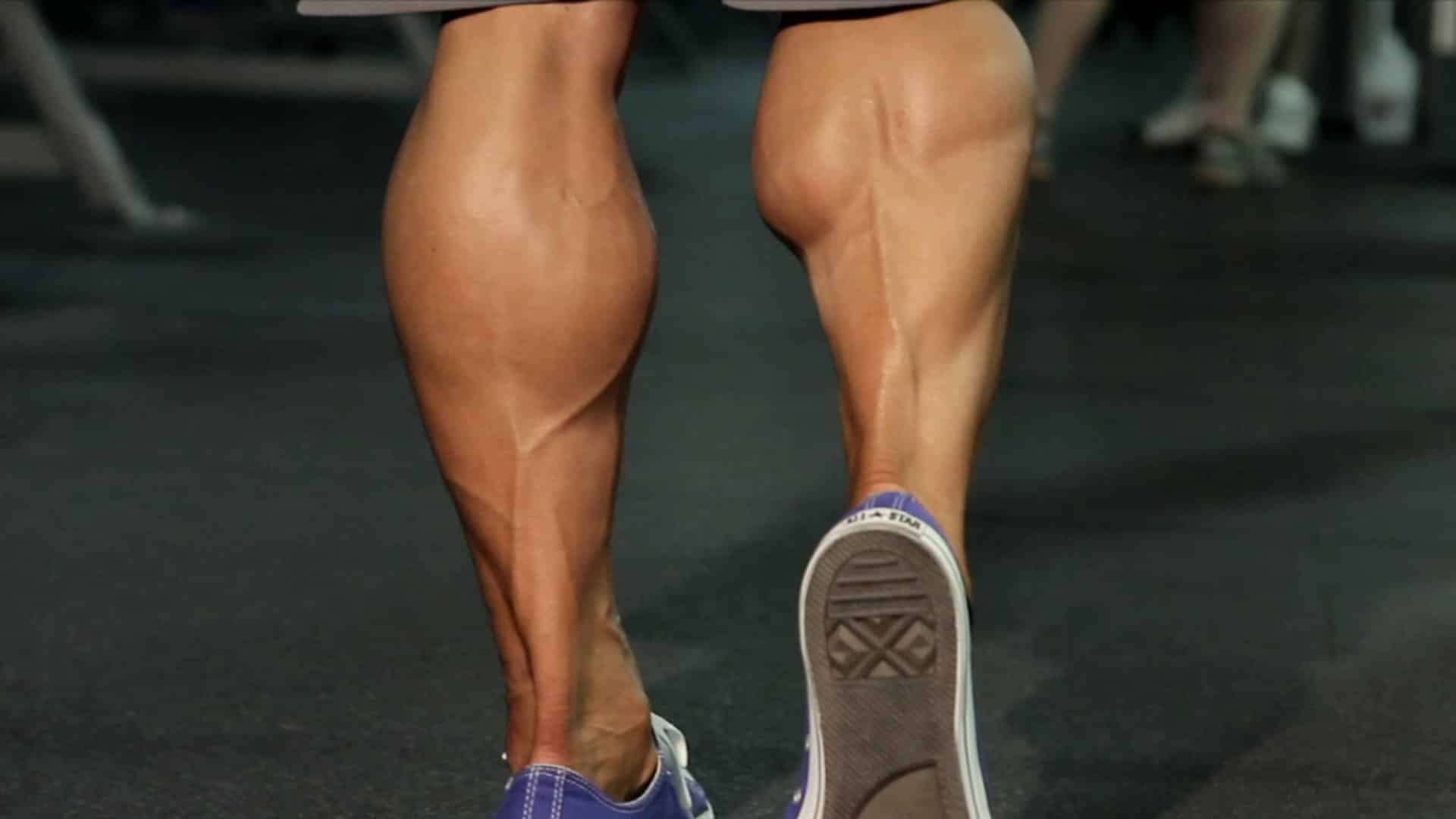
- What Are Your Calf Muscles
- Gastrocnemius
- Soleus
- 20 Best Calf Exercises For Mass
- 1. Barbell Standing Calf Raise
- 2. Donkey Calf Raise
- 3. Smith Machine Standing Calf Raise
- 4. Standing Dumbbell One Leg Calf Raise
- 5. Seated Machine Calf Raise
- 6. Seated Dumbbell One Leg Calf Raise
- 7. Hack Machine Calf Raise
- 8. Bodyweight Standing Calf Raise
- 9. Standing Dumbbell Calf Raise
- 10. Leg Press Machine Calf Raise
- 11. Dumbbell Step-Up
- 12. Jump Squat
- 13. Barbell Seated Calf Raise
- 14. Dumbbell Farmer’s Walk On Toes
- 15. Jumping Jack
- 16. Jumping Calf Raise
- 17. Machine Calf Raise
- 18. Staircase Climbing
- 19. Squat Hold Calf Raises
- 20. Box Jump
- How To Build Calf Muscle Mass and Strength
- 1. Drop Sets
- 2. Eccentric Training
- 3. Isometric Holds
- 4. Go Full Range Of Motion
- 5. High Reps and Short Rest
- 6. Plyometric Training
- 7. Mind-Muscle Connection
- 8. Increase the weight and intensity
- 9. Set and Reps for Calf workout
- Conclusion
- References
What Are Your Calf Muscles
The calf comprises two superficial muscles: the gastrocnemius and the soleus.
Gastrocnemius
- The Gastrocnemius is the larger, more visible muscle of the calf.
- It forms the bulge in the upper part of the lower leg and is responsible for the diamond-shaped appearance.
- This muscle originates above the knee joint and consists of two heads: the medial and the lateral.
- The Gastrocnemius contracts during activities like walking, running, and jumping, providing power and propulsion.
- The gastrocnemius does work when the knee is straight.
Soleus
- The soleus muscle is located underneath the gastrocnemius and stabilizes the ankle joint.
- While it doesn’t directly contribute to the visible shape of the calf, it is equally important for lower leg function.
- The Soleus is predominantly involved in maintaining posture, assisting with push-off during walking, and providing stability during activities such as standing and balancing.
- The soleus does the work whenever the knee is bent.
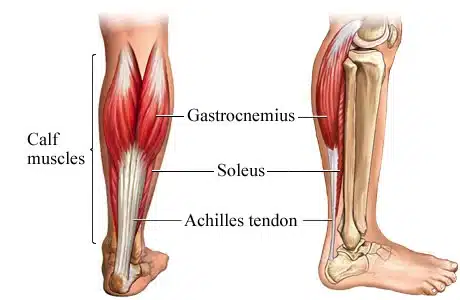
Want to take your gains to the next level? Discover your daily calorie needs with our free TDEE calculator
20 Best Calf Exercises For Mass
Here are 20 calf exercises to help you build strong, defined muscles.
1. Barbell Standing Calf Raise
The standing barbell calf raise is a highly effective exercise for targeting and developing the calf muscles. However, it also provides secondary benefits by engaging other muscle groups such as the quadriceps (quads), hamstrings, and gluteal muscles (glutes).
You can experiment with foot placement by pointing your toes slightly inward, outward, or straight ahead to target different areas of the calf muscles.
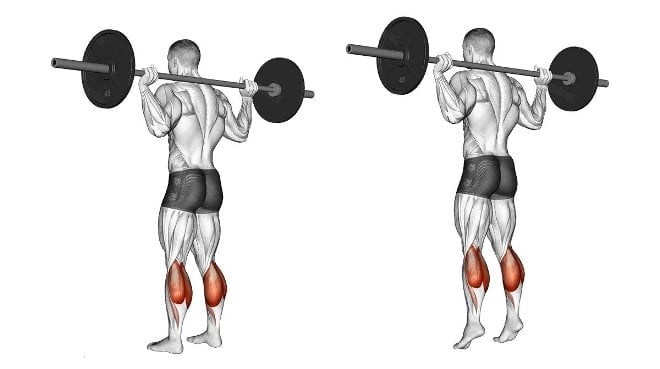
How To Do
- Grab a barbell and place it on your upper back, across your shoulders.
- You can use a squat rack or have a spotter assist you in getting into position.
- Stand with your feet shoulder-width apart and your toes pointing forward.
- Lift your heels off the ground by pushing through the balls of your feet.
- Rise as high as possible onto your toes, feeling a strong contraction in your calves.
- Hold the top position for a moment, then slowly lower your heels back down to the starting position.
Tips
- Start with a lighter weight to ensure proper form, and gradually increase it.
- Keep your back straight, chest up, and shoulders back
- Avoid using momentum or bouncing at the bottom of the movement.
Know More: 15 Best Barbell Leg Workout For Mass and Strength
2. Donkey Calf Raise
The donkey calf raise is a second option after standing calf raises.
Unlike standing calf raises, where your back can limit weight, the bent-over position of donkey calf raises allows you to lift heavier weights for greater muscle stimulation.
- It primarily targets both muscles that make up the calves: the gastrocnemius and the soleus.
- The donkey calf raises secondarily activates the hamstrings and abs.
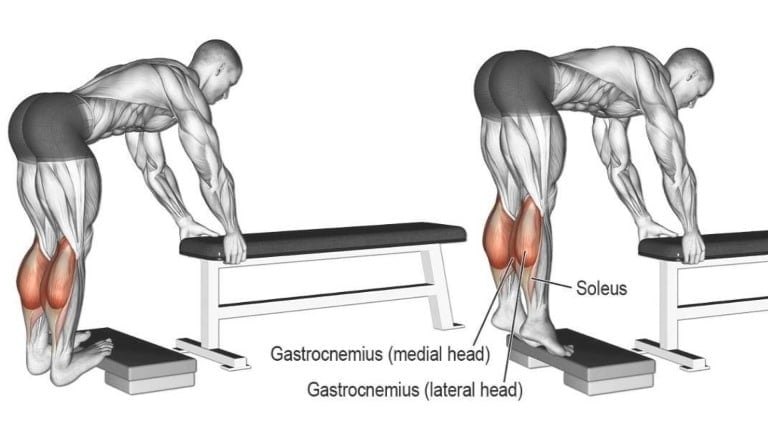
How To Do
- Find a sturdy, waist-high object like a railing or stable bench.
- Place an aerobic step or weight plate a couple of feet behind the object.
- Stand facing the object with your feet shoulder-width apart on the balls of your feet. Rest your toes on the edge of the step or plate.
- Hold on to the object for balance and bend forward at your hips. Your torso should be nearly parallel to the floor.
- Slowly lower your heels down as far as you can. Hold for a second at the bottom.
- Push your calves up and squeeze your calf muscles. Hold for another second.
- Slowly lower your heels back down to the starting position.
Tips
- You must go through full-range movements to target the calve muscles.
- Exhale as you raise your heels and inhale as you lower them.
- Use high blocks to ensure you are not limited in the range of your movements.
3. Smith Machine Standing Calf Raise
The Smith machine guides the bar along a fixed track, allowing you to lift heavier weights than free-weight calf raises.
Since your upper body is stabilized, you can focus your attention on contracting your calf muscles for a more isolated workout.
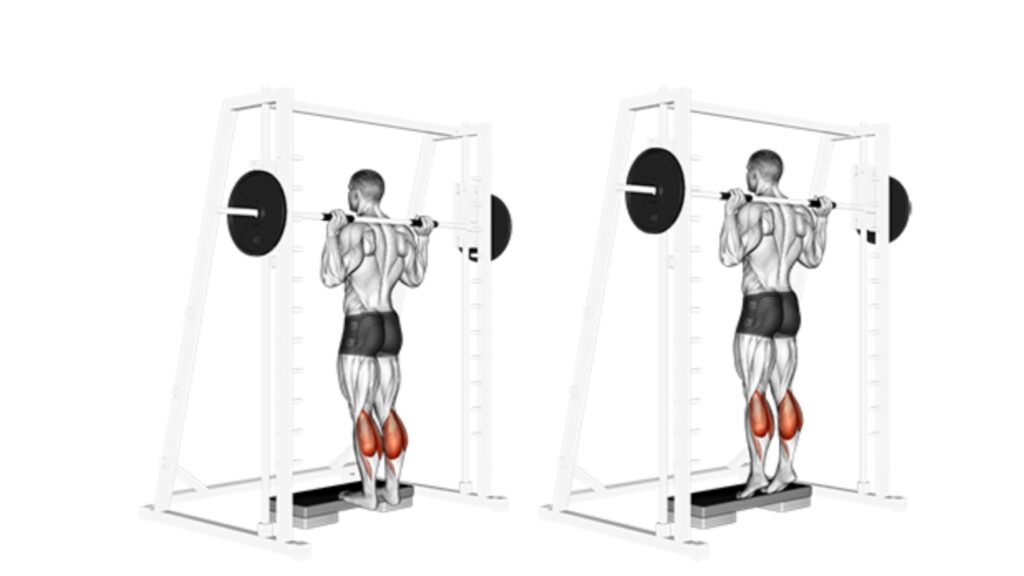
How To Do
- Adjust the Smith machine bar to a comfortable height, around shoulder level.
- Position yourself under the bar with your feet shoulder-width apart and the balls of your feet on the step/plate
- Rotate the bar so that it is unracked from the Smith machine.
- Push off the balls of your feet to raise your heels as high as possible.
- Flex your calf at the top of the contraction. Hold the contracted position for a second.
- Breathe in as you return to the starting position by lowering your heels.
Tips
- Be mindful of your knees. Keep them slightly bent to avoid locking them out.
- Don’t let your heels touch the floor throughout the set.
- To get the maximum range of motion, let your heels go as far as possible and raise them as high as possible.
Related Post: 12 Most Effective Smith Machine Leg Workout & Exercises
4. Standing Dumbbell One Leg Calf Raise
The single-leg variation of the calf raise makes your calf muscles work harder for greater muscle growth and strength gains.
This exercise allows you to address any imbalance between your left and right calves by working each leg individually.
If you don’t have a platform, you can do them on the floor.
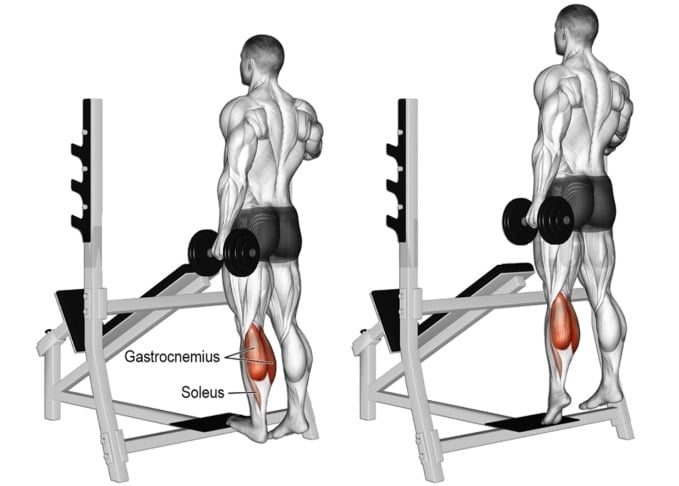
How To Do
- Hold a dumbbell by your side in your left hand.
- With your left foot, stand on a platform.
- Grasp something with your right hand for stability.
- Exhale as you raise your heel by extending your ankle.
- Hold for a count. Inhale as you slowly reverse the motion and lower your heel until you feel a mild stretch in your calf.
- Hold for a count of one. Repeat for more repetitions. Repeat with your right leg.
Tips
- Keep the movement slow and under control.
- Do not lock out your knee.
Related Post: 10 Best Dumbbell Quad Exercises To Build Mass And Strength
5. Seated Machine Calf Raise
The Seated Machine Calf Raise is a great exercise for targeting and isolating the calf muscles, particularly the soleus.
The seated position places your knees flexed, emphasizing the soleus muscle’s activation. You are less likely to hurt your lower back or knees when you do machine calf raises instead of free weights.
Since the soleus comprises slow-twitch muscle fibers, it helps to build the endurance required for running, cycling, and walking.
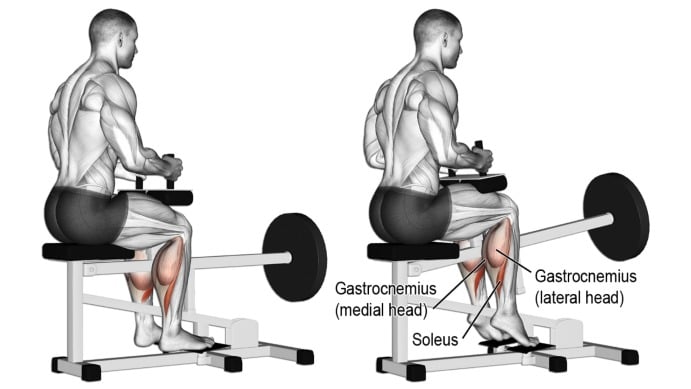
How To Do
- Sit in the seated calf machine and place your feet on the foot plate so that your heels hang off the edge.
- Place the knee pad on your knees and unrack the weight.
- Drop your heels as low as possible to get a good stretch in your calves.
- Lift your heels by contracting the calf muscles, raising the weight as high as you can on the balls of your feet.
- Hold this position for a second, flexing your calf muscles, then lower your heels back to the starting position.
Tips
- Do the reps in a controlled way and limit momentum at the movement’s top.
- To achieve the maximum range of motion, allow your heels to drop as far as possible and raise them as high as possible.
6. Seated Dumbbell One Leg Calf Raise
When doing a calf workout with a dumbbell, you can add plenty of calf exercises to correct potential imbalances.
It can be done with both legs simultaneously, but I recommend doing it one leg at a time to do it properly and safely.
The seated dumbbell calf raise can be used as an alternative to the machine seated one-leg calf raise if you do not have access to the seated calf raise machine.
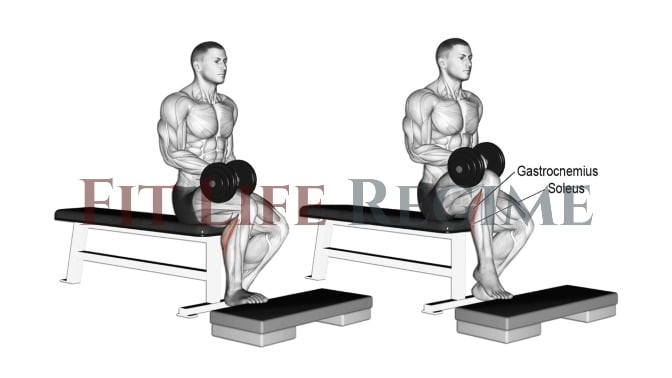
How To Do
- Sit with the front of your right foot placed on top of a block or step in front of you.
- Hips and knees should be bent at a ninety-degree angle.
- Dip the heel of your right foot as low as it can go.
- Hold a dumbbell vertically on top of your right knee.
- Exhale as you lift your right heel as high as possible, pushing against the dumbbell’s weight.
- Keep your right heel lifted for 2 counts. Slowly lower it as you inhale.
- Repeat the exercise on your left foot.
Tips
- Move slowly as you stretch your calf muscle.
- Make sure you hold the stretch for a second at the top, returning to the starting position.
Related Post: 7 Dumbbell Calf Exercises & Workouts For Bigger Calves
7. Hack Machine Calf Raise
The hack squat machine provides a deeper stretch at the bottom of the movement compared to calf exercises.
In this study, the researchers compare how different foot positions affect different areas of the calf muscles:
In this study, the researchers compare how different foot positions affect different areas of the calf muscles:
- If you turn your toes outward, your gastrocnemius’s inner (medial) head will be emphasized.
- However, if you turn your toes inward, the outer heads of your gastrocnemius will be activated.
- If you keep them pointing forward, your gastrocnemius’s inner and outer heads will be activated approximately equally.
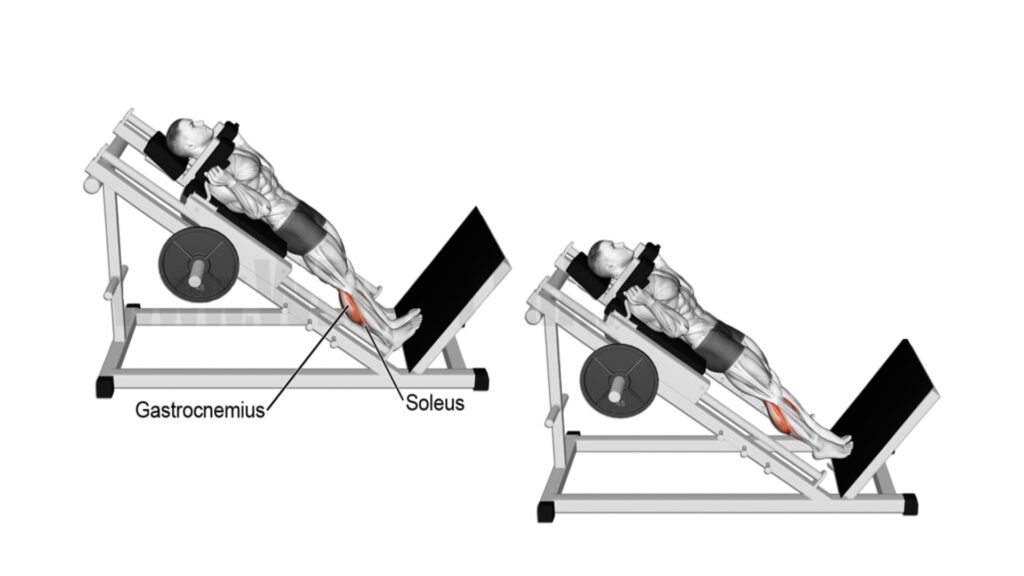
How To Do
- Stand on the hack machine platform with your back flat against the rest and the shoulder pads on top of your shoulders.
- Position yourself on the footplate with your toes pointed slightly outward or forward.
- Unlatch the hack machine from the rail.
- Exhale as you push the hack machine up and away from the platform.
- Pause briefly, then slowly lower the hack machine back to the starting position.
Tips
- Adjust the angle of your feet (toes pointed inward, outward, straightforward) to target different areas of your calves.
- Throughout the exercise, ensure your back is flat against the rest, your hips are extended, and your knees are almost fully extended.
8. Bodyweight Standing Calf Raise
Standing bodyweight calf raises (also known as heel raises) are a classic move for strengthening the calves.
It is an easy exercise. You can do it at home or pretty much anywhere because it only uses your bodyweight.
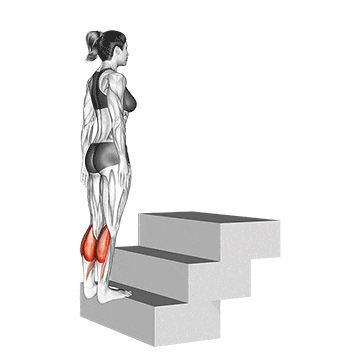
How To Do
- Stand up straight with your feet facing forward and hip-width apart.
- You can lightly place your hands on a wall or any available support for additional stability.
- Raise your heels by pressing the balls of your feet into the ground.
- You should raise your body until you are on your toes.
- At the top of the movement, gently squeeze your calf muscles for a brief pause.
- Slowly lower your heels back towards the ground.
- At the bottom, allow your heels to briefly drop slightly below the level of the balls of your feet to achieve a good stretch in the calves.
Tips
- Pause and squeeze for a count of 1-2 at the movement’s top for added intensity.
- Keep the balls of your feet on the edge of the block/step.
- Keep your knees slightly bent; don’t lock them out.
Know More: Bodyweight Leg Exercises For Mass, Strength And Power
9. Standing Dumbbell Calf Raise
This exercise can be performed anywhere with a dumbbell only. It allows you to increase your workout intensity as your calf gradually gets stronger.
There are many ways to do standing dumbbell calf raises. Like single leg, on the floor…
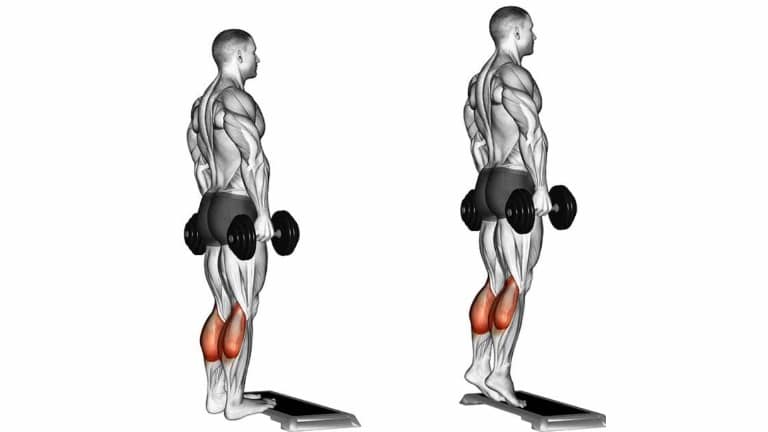
How To Do
- Hold a weight in each hand. Stand up straight on the stepper with your feet facing forward and placed hip-width apart.
- Keep a slight bend in your knee and hold your hands by your side.
- Raise your heels by pressing the balls of your feet into the ground or steeper.
- You should move your body upwards until you’re standing on your toes.
- Hold this position, and slowly lower your heels back to the ground or below.
Tips
- Pause and squeeze for a count of 1-2 at the movement’s top for added intensity.
10. Leg Press Machine Calf Raise
Working your calves on the machine offers significant advantages in comparison to performing standing calf raises.
- The supported upper body position allows you to lift heavier weights.
- It supports your upper and lower back; hence, you have a good option if you have a back problem.
- Enable you to achieve a deeper stretch in your calves at the bottom of the movement
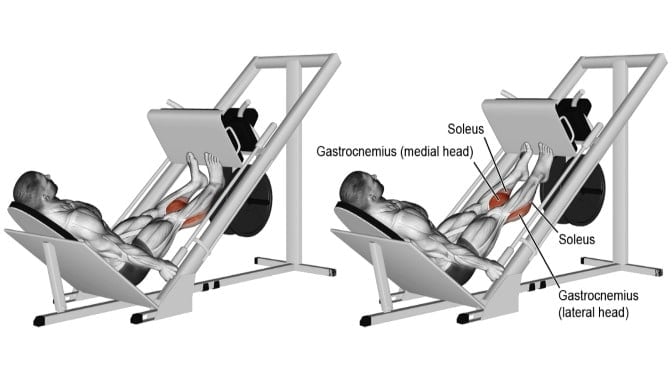
How To Do
- Sit in a leg press machine and place your feet on the bottom of the footplate so that your heels hang off the footplate.
- Press the footplate up from the safety hooks (but do not unlatch them) by straightening your legs.
- Drop your toes down toward your shins to stretch your calves.
- Press the weight up with your toes by contracting your calf muscles.
- Hold this position for a second, then lower your heels back to the starting position.
Tips
- Keep the repetitions slow and controlled. Limit momentum and pause at the top to emphasize the contraction.
- Try to move through the ball of the foot rather than the base of the toes.
- To perform the exercise correctly and safely, you must wear proper footwear. No slippers.
11. Dumbbell Step-Up
The dumbbell step-up is a great exercise for building lower-body strength and power. This workout targets hamstrings and quadriceps and also involves calves, glutes, and hip flexors.
It is a great all-round exercise that is perfect for everyone. It can be modified to create a challenging workout for anyone, whether they have just started exercising or have been training for years.
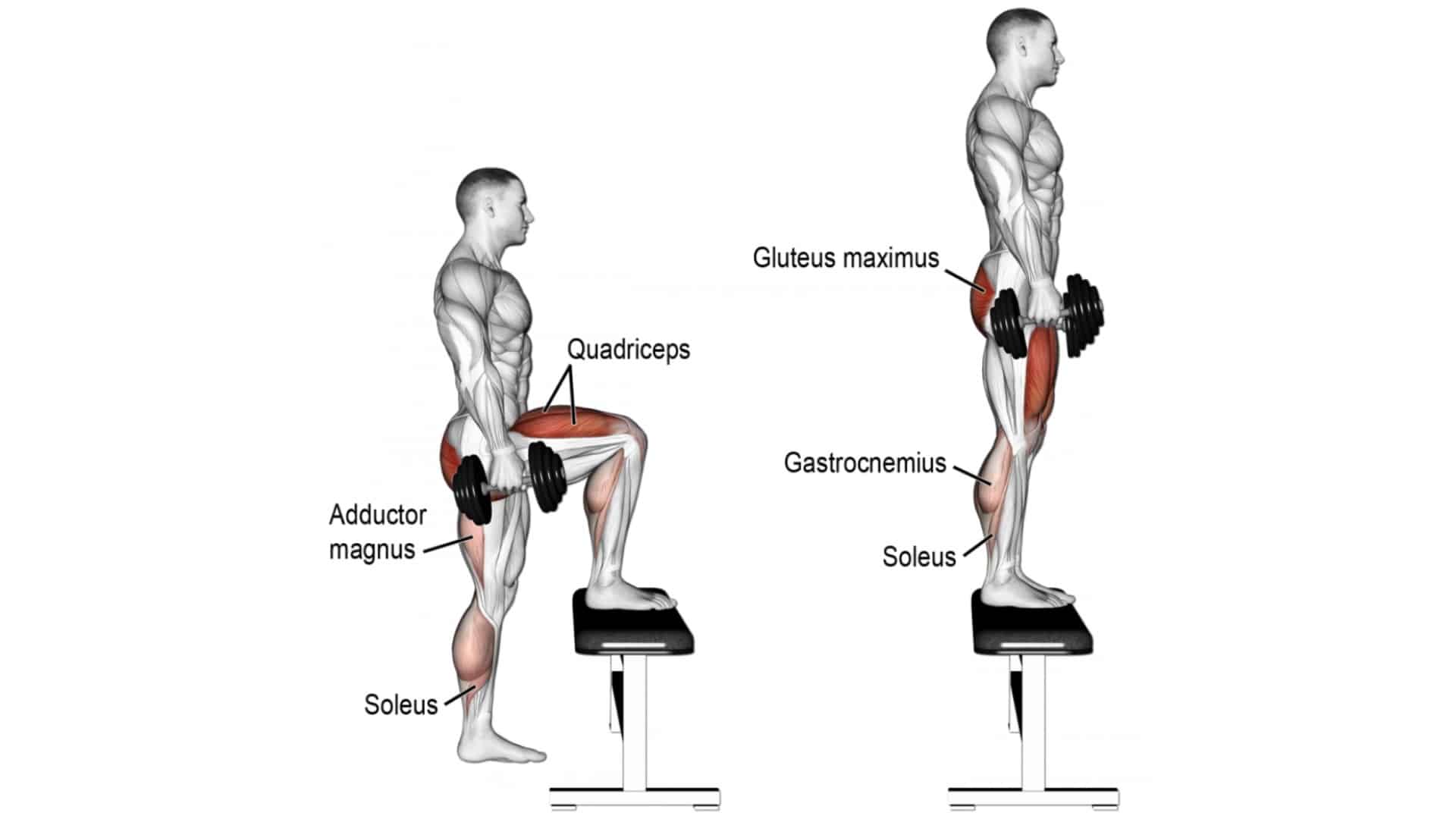
How To Do
- Place a knee-high box or bench in front of you and grasp a dumbbell in each hand, or use just your body weight.
- Stand with your feet in a comfortable hip-width stance.
- Step forward with one leg onto the step and drive through that thigh to bring your body upward.
- Bring the trailing leg to the top of the step and stand on the box.
- Then step back with the opposite leg to the floor and lower yourself—alternate legs with each rep.
Tips
- Control the movement, using your muscles to lift and lower yourself slowly.
- Be sure to keep your lower back in its natural arch and your upper body upright throughout the whole movement.
- Keep your body upright and your feet and knees pointing in the same direction.
12. Jump Squat
Jump squats are the power packed HIIT version of squats. Squat jumps and their variations help shed fat from the lower body, tone your butt and legs, and improve strength and balance.
This exercise is often used as the beginning movement to develop proficiency in the vertical, high, long, and box jumps.
Squat jumps are a great exercise to include in-home workouts since they can be done in a small space without any equipment.

How To Do
- Stand with your feet about shoulder-width apart and your knees slightly bent.
- Quickly drop by bending at the knees and hips, letting your glutes track backward, and lowering yourself into a squat.
- At the point where your thighs are parallel to the floor, quickly and explosively reverse direction, driving up through your heels and the balls of your feet to lift your body off the floor as high as possible.
- Land with soft knees and immediately lower into the next rep.
Tips
- Keep your head up and your torso upright.
- Don’t perform this exercise with cold muscles. Do a cardio warm-up before it.
13. Barbell Seated Calf Raise
The barbell seated calf raise is a great variation of the seated calf raise if you have limited equipment (e.g., a home setup). However, you can still utilize it as a gym exercise.
This is a very useful exercise if you can’t access a seated calf-raise machine.
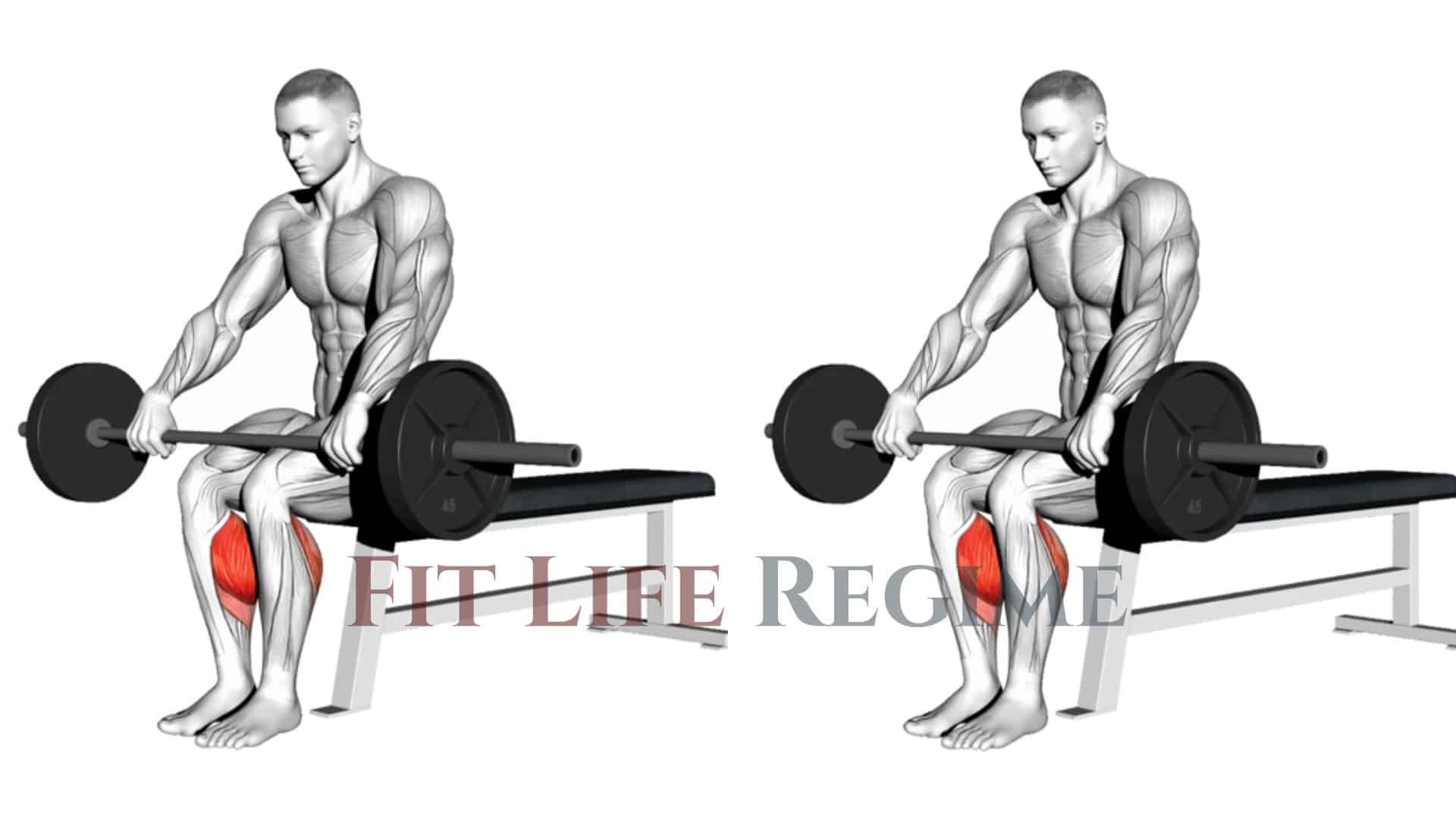
How To Do
- Sit on the end of a bench or chair and place the barbell on the end of your thighs near your knee, but not on your knee.
- Sit up straight and place the top half or balls of your feet on the floor or elevated object so your heels hang off.
- Lift your heels by contracting the calf muscles, raising the weight as high as you can on the balls of your feet.
- Hold this position for a second, flexing your calf muscles, then lower your heels back to the starting position.
Tips
- Have a firm grip on the barbell to keep in it in one place.
- Perform the reps nicely and slowly using a full range of motion.
14. Dumbbell Farmer’s Walk On Toes
The farmer’s walk exercise is simple but extremely effective, as it requires using your legs, calves, forearms, and core.
However, you can perform the farmer walks on the toes. That way, you will amplify the calf muscle.
You should try the exercise without weights first, and then add or increase the weights as you feel comfortable and more stable.
Then, you can grab some dumbbells or kettlebells and start walking on your toes.

How To Do
- Grab a set of dumbbells and hold them at your sides with your arms extended.
- Stand together with a long, tall spine and feet, and brace your core strongly.
- Rise onto the balls of your feet. Take a small step forward, staying as high on your toes as possible.
- Continue moving forward, taking 20-30 small steps.
15. Jumping Jack
Jumping Jack is a popular aerobic exercise that involves jumping while simultaneously spreading the legs wide and raising the arms overhead.
It is a full-body exercise that improves cardiovascular fitness, increases calorie burn, and engages multiple muscle groups.
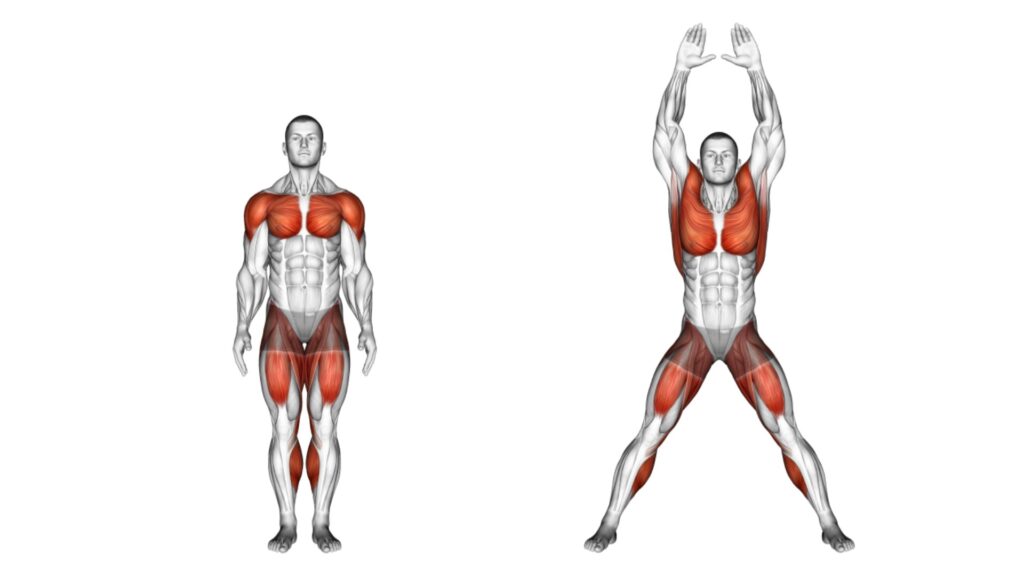
How To Do
- Stand with your feet together and arms resting by your sides, maintaining proper posture.
- In one swift motion, jump up while spreading your legs out to the sides.
- As you jump, raise your arms overhead and touch your hands together.
- Quickly return to the starting position by jumping again, bringing your legs together, and lowering your arms back to your sides.
Tips
- Keep your back straight, core engaged, and land softly on the balls of your feet.
- Inhale deeply as you jump, and exhale forcefully as you return to the starting position.
16. Jumping Calf Raise
The Jumping Calf Raise is a dynamic exercise that targets the calf muscles while incorporating a plyometric or explosive element.
It helps strengthen and develop the calf muscles while improving power and explosive strength.
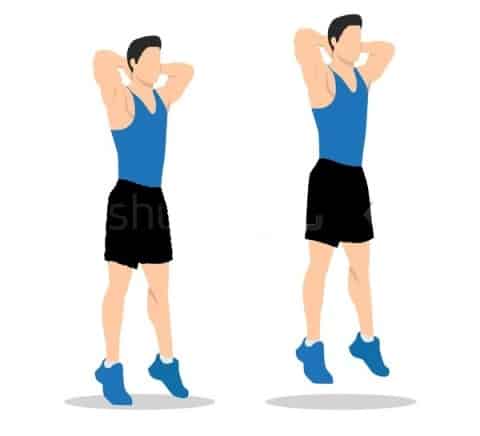
How To Do
- Stand with your feet hip-width apart, toes pointing forward, and arms by your sides.
- Start by performing a regular calf raise: Rise onto the balls of your feet by pushing through your toes and lifting your heels off the ground. This is the starting position.
- From the starting position, explosively jump off the balls of your feet, propelling your body upward.
- While in the air, quickly extend your ankles and point your toes down, fully contracting your calf muscles.
- Land softly on the balls of your feet and immediately perform another explosive jump to begin the next repetition.
Tips
- If you’re new to jumping calf raises, begin with regular calf raises to build strength and familiarity with the movement.
- Focus on landing gently and quietly to minimize impact on your joints.
- Bend your knees slightly as you land to absorb the shock.
- Start with fewer repetitions and gradually increase the intensity, height, or speed.
17. Machine Calf Raise
If there is only one exercise you want to do for your calves with a machine, then it should be this one.
Standing calf raises targets the whole gastrocnemius muscle.
A wide stance emphasizes the inner (medial) head, whereas a narrow stance targets the outer (lateral) head.
To maximize the range of motion, aim for a full stretch at the bottom and full squeeze at the top.
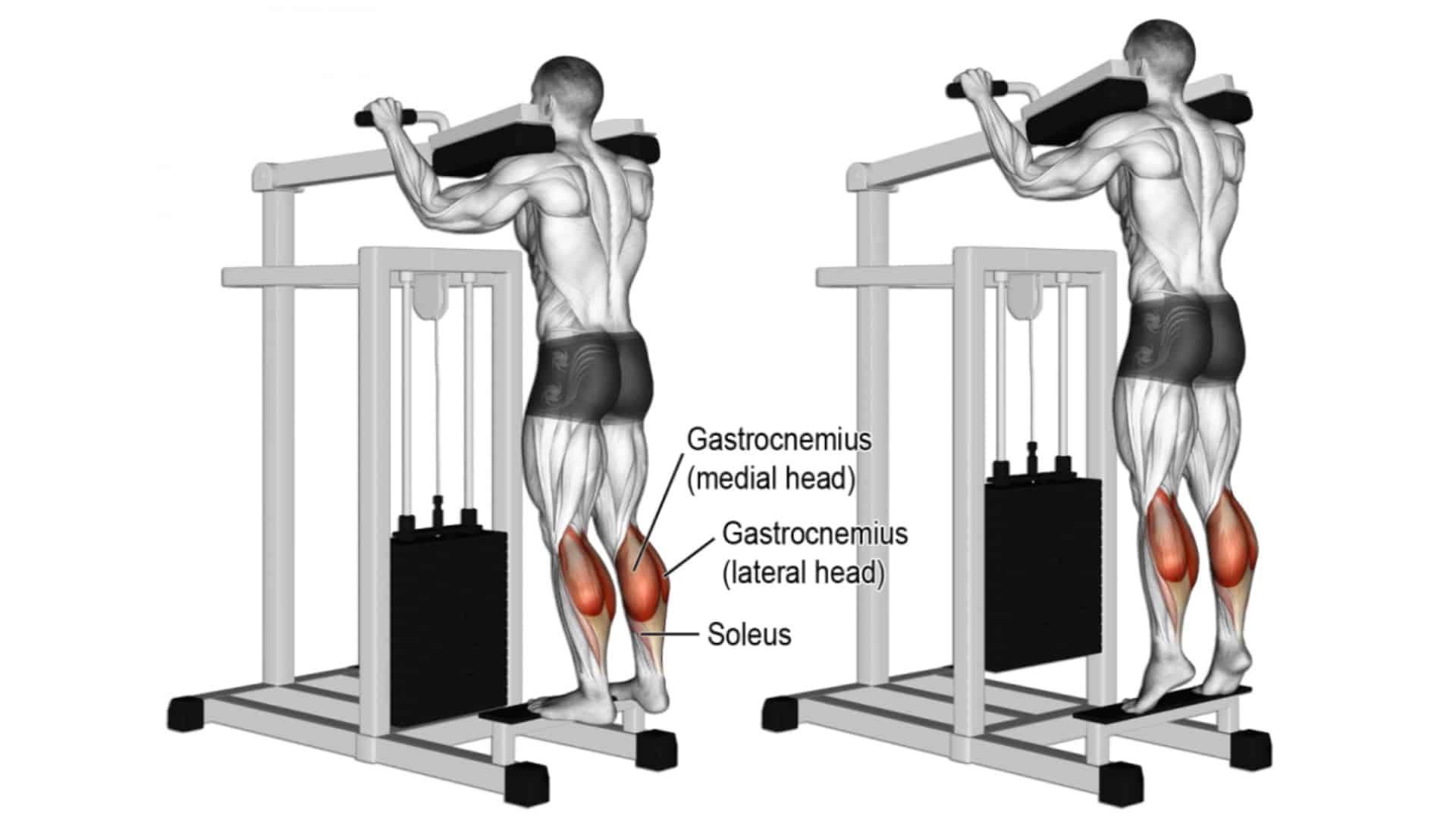
How To Do
- Step on a Calf raise machine with your toes on a block, and the heels extend into space.
- Place the shoulders under the pads and hook the weight of the support.
- Now raise yourself up using only the toes and come as far as possible.
- Hold this position for a second, flexing your calf muscles.
- Slowly lower your heels as far as possible towards the floor. Keep your knees slightly bent.
- Go as heavy as possible. With time, you can perform partial repetitions once you tire on a set.
Tips
- The movement too quickly isn’t effective—it’s best to raise and lower your heels slowly.
- Keep your chest up and stand tall to stay properly balanced while performing calf raises.
- To help keep your balance, keep your eyes facing forward at all times.
18. Staircase Climbing
Staircase climbing is a cardiovascular exercise that involves climbing up and down a set of stairs.
It is a highly effective way to improve cardiovascular fitness and strengthen leg muscles, especially calf and quad muscles.
To increase the intensity of your workout and add variety and challenge, you can incorporate intervals of faster-paced climbing or skipping steps.
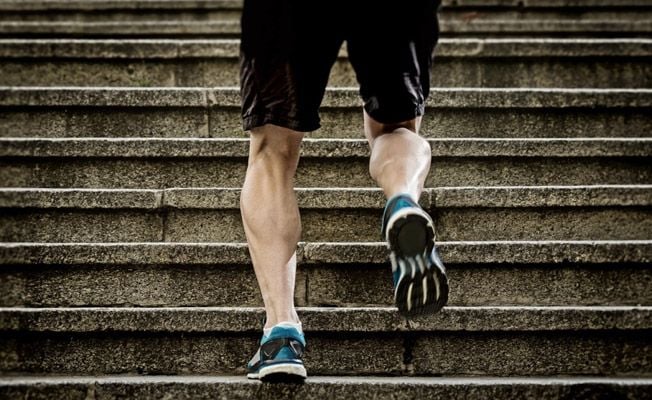
How To Do
- Look for a set of stairs that are safe and suitable for climbing.
- Begin at the bottom of the stairs and climb up, one step at a time.
- Use proper form: Keep your posture upright, engage your core, and look forward while climbing.
- Use your entire foot to push off from each step, and avoid using only your toes or heels.
- Find a comfortable pace that allows you to keep moving continuously.
- Once you reach the top, carefully descend the stairs by walking down or using a controlled jogging motion.
Tips
- Take each step deliberately and be cautious to avoid tripping or slipping.
- Breathe deeply and rhythmically throughout the exercise
19. Squat Hold Calf Raises
Squat-hold calf raises work the soleus muscles more than the gastrocnemius, but the latter still produces considerable force.
While maintaining the squat position, the individual pushes up to stand on their tip toes and then back down to the ground. You should try this bodyweight calf raise exercise.
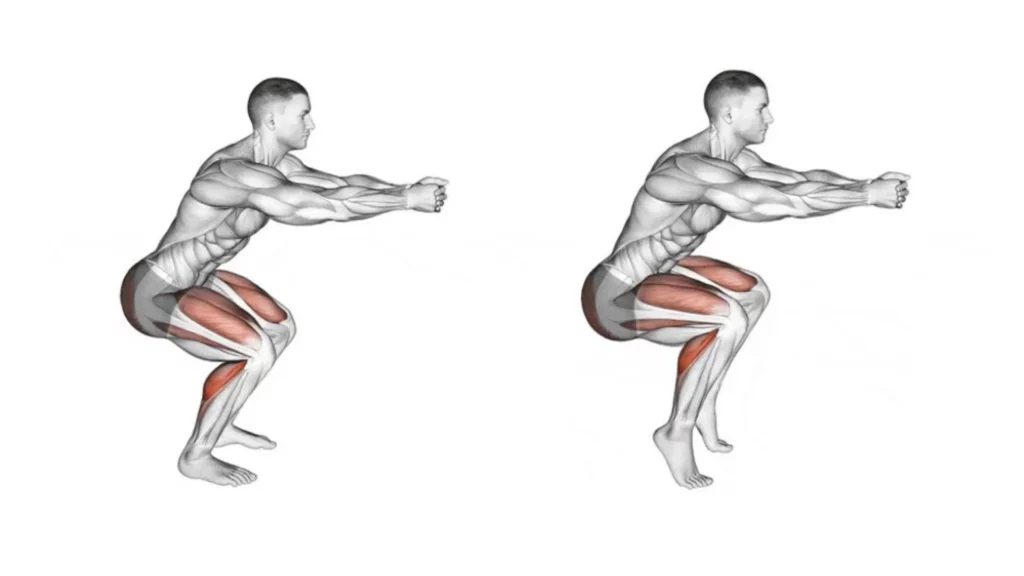
How To Do
- Stand with your feet about three to four feet apart, toes turned out.
- Bring your hands together in front of your chest.
- Squat down by bending at the knees and hips, letting your glutes track backward to lower yourself into a squat.
- Raise your heel off the floor and squeeze your calves.
- Repeat until the set is complete.
Tips
- Keep your abs tight, your back straight, and maintain your knees in line with your toes.
20. Box Jump
The box jump is a plyometric exercise that develops an athlete’s lower body explosiveness and proprioception.
Plyometric exercises like the box jump help improve explosiveness, which combines power and speed to output force from the exerciser’s body.
This exercise is commonly used as part of an athletic training circuit. It provides both a leg muscle training stimulus and sports-specific skill development, such as proprioception, lower body stability, and multijoint movement coordination.

How To Do
- Stand in front of a sturdy box or platform with your feet shoulder-width apart.
- Lower yourself into a quarter squat position, swinging your arms back for momentum.
- Explosively jump upwards, swinging your arms forward to help propel you upwards.
- Land on the box with both feet, ensuring you have fully extended your hips and knees at the top of the jump.
- Step back down from the box and repeat for the desired number of reps.
Tips
- Start with a lower box height and increase it as you get stronger and more skilled.
- Use a sturdy box or platform to support your weight and not slip or slide during the exercise.
- Land softly and quietly on the box to minimize the impact on your joints.
How To Build Calf Muscle Mass and Strength
To build three-dimensional calves, you need many approaches, such as constantly working those muscles’ concentric and eccentric contractions from variable angles.
Try out the techniques and approaches and see which ones work best for you.
1. Drop Sets
Drop sets involve performing an exercise to failure, then immediately reducing the weight and continuing the exercise.
This technique can be used for any calf exercise like standing calf raises or seated calf raises.
2. Eccentric Training
Eccentric training involves focusing on the lowering phase of an exercise.
For example, when performing standing calf raises, focus on lowering your heels slowly and keeping them under control. This technique can help to stimulate muscle growth and increase strength.
Eccentric reps stress the muscles a lot, so I recommend doing them almost every other week.
3. Isometric Holds
Pause for a few seconds at the peak contraction of each calf raise. This isometric hold challenges the muscles and enhances muscle recruitment.
Gradually increase the duration of the holds as your strength improves.
4. Go Full Range Of Motion
Do a Full range of motion and Go all the way up and all the way down when you do your calf raises (but avoid relaxing at the bottom, which stresses the connective tissues).
5. High Reps and Short Rest
Giving calf muscles a big pump by forcing a large amount of blood into a muscle is one way to encourage growth.
The best way to get a good pump is with high reps (20-50) and short rest (30-60 seconds) in between sets.
6. Plyometric Training
Jumping rope, jumping squats, or single-leg hops are some explosive plyometric exercises you can do for your calf workouts.
Plyometrics enhance power and explosiveness, which can translate to improved athletic performance.
7. Mind-Muscle Connection
Focus on developing a strong mind-muscle connection with your calves during each rep.
Concentrate on feeling the muscles working and contracting with each movement to maximize the effectiveness of your training.
8. Increase the weight and intensity
Varying rep strategies are also critical. Think of doing reps between 10 and 25, alternating between volume and strength days. That also means that you shouldn’t be afraid to load up the weight on those strength days, either.
Pick two or three of these calf exercises to do two or three times a week. Do three sets of each.
Your calves are used to high-volume work (think of how much they support you when you walk all day), so they can be trained more frequently.
9. Set and Reps for Calf workout
Of course, the number of sets and reps will be determined based on your fitness journey. The development of calf muscle mass and strength is achieved through a variety of set and repetition ranges.
Sets
- Beginners: Start with 4-6 sets per week.
- Most intermediate-advanced lifters require a minimum of 8 sets of direct calf work per week to make noticeable gains.
- For people who train twice a week, this is about 4 sets per session.
- If following a 3x training frequency, aim for around 2–3 sets per session.
Reps
- less than 6 reps for strength
- 6 to 12 reps for hypertrophy
- 12 to 20+ reps for endurance
Also, do fewer workouts per week (around 1-2), including lower rep ranges of 6-12 reps, to give yourself more variety and work different muscle fibers.
Conclusion
The calf muscle group is one of the most difficult to grow. To strengthen it, you should train them effectively.
- Set calves are a high priority; treat them that way by training them first on leg day.
- Emphasize high volume and perform at least 20 reps per set. Keep it under 20–25 reps per set.
- Include one standing and one seated exercise per calf workout.
- If you want to grow your calf, you need to focus on the squeeze and contraction—i.e., the top part of the movement.
- Do not overtrain, as this will lead to fatigue and breakdown. Two to three days a week is enough for a calf workout.
You can achieve the strong and defined calves you’ve always wanted with various exercises, proper form and technique, and proper nutrition and recovery.
References
- Ema R, Ohki S, Takayama H, Kobayashi Y, Akagi R. Effect of calf-raise training on rapid force production and balance ability in elderly men. J Appl Physiol (1985). 2017 Aug 1;123(2):424-433.
- Vissing, K., Brink, M., Lønbro, S. et al. Muscle Adaptations to Plyometric vs. Resistance Training in Untrained Young Men. Journal of Strength and Conditioning Research.
- Nunes JP, Costa BDV, Kassiano W, Kunevaliki G, Castro-E-Souza P, Rodacki ALF, Fortes LS, Cyrino ES. Different Foot Positioning During Calf Training to Induce Portion-Specific Gastrocnemius Muscle Hypertrophy. J Strength Cond Res. 2020 Aug;34(8):2347-2351.
- Fukunaga T, Roy RR, Shellock FG, Hodgson JA, Day MK, Lee PL, Kwong-Fu H, Edgerton VR. Physiological cross-sectional area of human leg muscles based on magnetic resonance imaging. J Orthop Res. 1992 Nov;10(6):928-34.
- Möck, Sebastian & Hartmann, René & Wirth, Klaus & Rosenkranz, Gregor & Mickel, Christoph. (2018). Correlation of dynamic strength in the standing calf raise with sprinting performance in consecutive sections up to 30 meters. Research in Sports Medicine. 26. 1-8. 10.1080/15438627.2018.1492397

Manish brings over 10 years of hands-on experience in weight lifting and fat loss to fitness coaching. He specializes in gym-based training and has a lot of knowledge about exercise, lifting technique, biomechanics, and more.
Through “Fit Life Regime,” he generously shares the insights he’s gained over a decade in the field. His goal is to equip others with the knowledge to start their own fitness journey.
